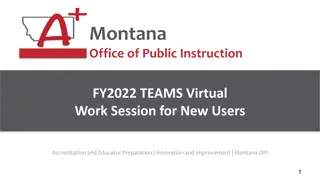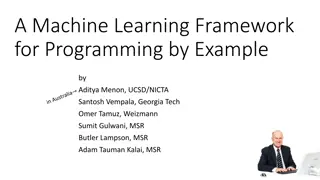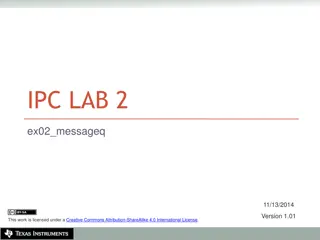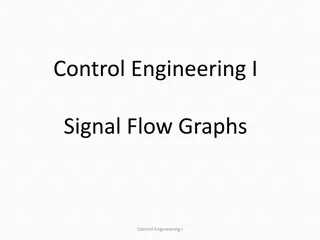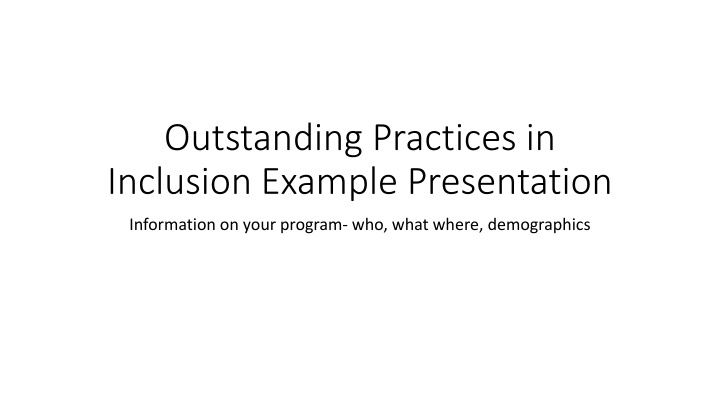
Effective Inclusion Practices for Diverse Learning Environments
Explore exceptional practices in creating inclusive learning environments, featuring accessible spaces, accommodations for individual needs, collaborative goal-setting with families, and integrated instructional strategies. Witness how teachers and staff promote positive interactions and social engagement among all children in the program.
Download Presentation

Please find below an Image/Link to download the presentation.
The content on the website is provided AS IS for your information and personal use only. It may not be sold, licensed, or shared on other websites without obtaining consent from the author. If you encounter any issues during the download, it is possible that the publisher has removed the file from their server.
You are allowed to download the files provided on this website for personal or commercial use, subject to the condition that they are used lawfully. All files are the property of their respective owners.
The content on the website is provided AS IS for your information and personal use only. It may not be sold, licensed, or shared on other websites without obtaining consent from the author.
E N D
Presentation Transcript
Outstanding Practices in Inclusion Example Presentation Information on your program- who, what where, demographics
1A. Learning Environment* 1 - Program and classroom spaces are accessible to all children to support access and participation in all routines and learning including: Adaptive furniture and equipment for routine care Indoor and outdoor play and learning Include photos, video or documents that show what has been implemented in routines and learning.
2 - Accommodations are made to classroom play and teaching materials to support each child's participation in: peer interactions the general curriculum learning opportunities related to their own individual goals and outcomes. Share examples- photos, videos or documents that touch on each aspect Don t forget to make the connection back to individualized goals for children with disabilities.
Teachers, other direct service staff, and administrative support staff collaborate with families to identify goals and outcomes to incorporate into play, activities, and classroom routines from: the general education curriculum & from individual education and service plans ( i.e. IFSP/IEP) Examples of how your Team collaborates with families to identify goals that are embedded throughout the program. Some of these examples will be general preschool goals and some will be targeted to align to IEP goals. This could include lesson plan examples, as well as bi directional communication examples with families discussing goals strategies etc
1C. Instructional Quality 4 - Strategies, supports, and services identified in individual service plans are: provided in the classroom & embedded into classroom play, activities, and routines. Examples of lesson plans, noting related service delivery in classroom, embedding goals, Pictures or video clip Example Schedule for a support person
5 - Classroom and program staff help each child engage in positive, sustained social interactions and play with peers, and provide opportunities for each child to be a fully participating member of the classroom community. Examples of engagement strategies, how the children all members of the classroom Pictures or video Story of example of supporting peer interactions
6 - Classroom staff support development and learning by matching individual support strategies (modeling, asking questions, and prompting) to abilities, goals, and intended outcomes of individual children. Example of how team meets individual goals for children Could be picture, short story of example, video, lesson plan or team planning notes
1D. Child Screening 7 In addition to broad-based screening, teams us multiple sources of information to identify and refer children and families who may benefit from further evaluation or specialized services: Specific markers (e.g., low energy, withdrawal, acting out) Targeted screening (e.g., social emotional screening) & Ongoing observation and documentation What screeners do you use? Do you use specific screeners for a particular focus? How do you use the information gathered? Do you use other methods besides a formal screener? Share the strategies and or procedures used to gather data
1E. Child Assessment 8 - The program has written procedures and guidelines for gathering information from families on: their priorities, goals and desired outcomes for their child's participation in the program, family routines and strategies that support their child's development and learning. Share where the procedures and guidelines are kept- How do you implement? Share example of form or meeting template or any other way to share how you gather info from families on Goals/outcomes they have Routines and strategies they use at home
9 - Classroom and special service staff collaborate in: implementing and using initial and ongoing assessment for classroom and special service planning, summarizing and reviewing individual and group outcomes for evaluation and modification of classroom effectiveness. Examples of how teams collaborate using assessment info to plan and how they adjust once more data and information is collected evidence: lesson plan, individual intervention plans, team meeting notes/agendas, family conference notes, etc.
1F. Inclusion of Children with Disabilities - Written policies and procedures encourage and support collaboration and partnership among internal and external personnel and agencies, with family consent, serving the same child and family, including specific guidelines for joint planning, decision-making and problem solving related to educational, behavioral, medical, adaptive, social service, or other individual needs and resources Where is the policy? Does it include internal and external partnerships? Joint planning- for example are partners/agencies invited to IEP meetings as needed? This could be included in your mission and vision too How do you implement- share an example
11 - Program's advisory committee and/or parent board is regularly updated about policy and practices related to inclusion and disabilities, and actively recruits parents of children with disabilities for service on the committee or board. Share program advisory body information Examples could include: Agenda, membership demographics, schedule of meetings How do you recruit parents of children with disabilities to participate?
2A. Family and Community Engagement 12 - Families of children with disabilities are included in all family activities provided or facilitated by the program, and information about the program's vision and strategies for inclusion of all children is shared with all families. How do you assure families of children with disabilities are invited to family activities? Do you make any accommodations for families of children with disabilities? How is information about your program vision shared? How is information about inclusion in your program shared?
13 - Written policies and procedures encourage and support families of children with disabilities as partners: in screening, assessment, choosing desired outcomes and setting goals, and instruction related to their child support frequent communication between families, classroom and other direct service staff; & involve families in evaluating the program in relation to their goals and desired outcomes for their children. Do you have a policy on parental involvement? Do you do any special outreach to parents of children with IEPs. Do you do an overall program evaluation? Do you include inquiries about how families feel their child is being supported to reach their goals? Share examples of how you do these
14 - Teachers collaborate with families, other service staff, and administrative support staff to incorporate individual and classroom goals, strategies, and supports into family routines at home and in the community. Share examples of collaboration between families, program staff to use strategies beyond the school day at home and in the community. Share Pictures, documents or story
15 - Written policies and procedures identify and promote access to internal and external resources that assist families in accessing needed systems, services, and public benefits working with their child both within the program and in the community, including: receiving individual support for finding, understanding, negotiating, participating in, and coordinating services among Early Intervention, special education and other systems (e.g., social services, health, supplemental security income). How do you support families in accessing resources beyond those in your program? Share procedures or policy Share example of this in action for a child and family Could include MOUs with partners, transition agreements, etc.
16 - The program administrator and other management staff (e.g., administrative support staff) participate regularly in community and state systems and activities that support public knowledge of and coordination and integration among services for children and families, including those with disabilities, and provides leadership for high quality inclusion within the program. Share statewide committees or professional organizations that the program leaders participate in. Share any conference presentations your team has done Share any activities that promote inclusion beyond your program
17 - Written agreements support collaboration among members of the local early childhood community (child care, the Early Intervention system, Head Start, public school early childhood program), including written procedures, roles, and responsibilities for shared tasks and activities (e.g., identifying children and families in need of services, sharing information, coordinating services, providing special services to children with disabilities and their families, evaluating child and family outcomes). MOUs with community partners Share an example of how these agreements are used to support families build relationships with partners
2B. Transitions 18 - Program policies, procedures, and practices to support transition of children with disabilities entering into and exiting from the program are included in partnership agreements and include: timelines, roles, and responsibilities of both sending and receiving programs responsibilities for sharing and transferring records. Share transition agreements Calendars An example of these agreements in action
3B. Group Size and Ratios 19 - Early childhood programs and classrooms within which children with disabilities are served meet agency, state, and federal requirements for programs and classrooms that include children with disabilities and their families. Share the # of classrooms, # of sections # of children in classrooms with and without IEPs How do you plan so you keep classrooms within IDEA and ISBE rules and regs?
3C. Continuous Quality Improvement 20 - Program administrators engage staff in systematic, collaborative initial and ongoing program and classroom self-assessment using the Illinois Inclusion Guidelines Checklist, and demonstrate progress toward achieving program goals based on results of the assessment, as stated on an individual program development plan. How have you used the IIGC? Share data, professional learning, self reflections, action plans or other example of documentation of using the guidelines to review and improve your program
21 All program staff engage in systematic initial and ongoing self-assessment using the Inclusive Classroom Profile, and demonstrate progress toward achieving classroom and individual professional development goals based on results of the assessment. How have you used ICP? Share evidence of Professional Learning Self reflections Any classroom assessment? Do you have future plans with the tool or practices?
You Did It! Thanks!












